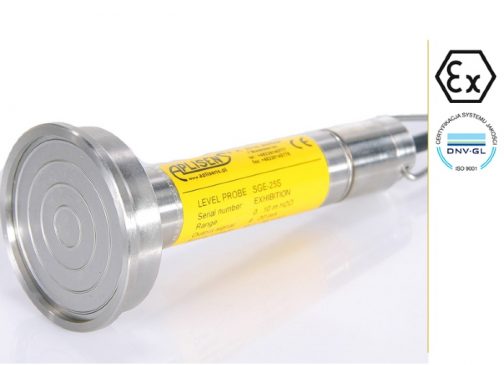
Hydrostatic level probe SGE-25/HASTELLOY
The SGE-25/HASTELLOY hydrostatic level probe is applicable to measure liquid levels in tanks where probe made in stainless steel can’t be used – e.g. in seawater or chemical applications. Principles of operation, construction
The probe measures liquid levels, basing on a simple relationship between the height of the liquid column and the resulting hydrostatic pressure. The pressure measurement is carried out on the level of the separating diaphragm of the immersed probe and is related to atmospheric pressure through a capillary in the cable.
The active sensing element is a piezoresistant silicon sensor separated from the medium by an isolating diaphragm. The electronic amplifier, which works in combination with the sensor, and is meant to standardize the signal, is additionally equipped with an overvoltage protection circuit, which protects the probe from damage caused by induced interference from atmospheric discharges or from associated heavy current engineering appliances.
When lowered to the reference level, the probe may either hang freely on the cable or lie on the bottom of the tank. The cable with the capillary can be extended using a standard signal cable. For the cable connection a special Aplisens SG cable hanger is recommended. The cable connection should be situated in a non-hermetically sealed box (the internal pressure inside the box should be equal to the atmospheric pressure), preventing water or other contaminants from getting into the capillary. The Aplisens PP junction box is recommended For systems with long signal transmission lines, it is recommended the using of an additional Aplisens UZ-2 overvoltage protection circuit in the form of a wall-mounted box which allows the cables connection. When the probe cable is being wound up, the minimum winding diameter should be 30cm and the cable should be protected from mechanical damage.
If there is a possibility of turbulence in the tank (for example, because of the mixer operating mixers or a turbulent inflow), the probe should be installed inside a screening tube (e.g. made of PVC). If the probe is to be lowered deeper than 100m, the cable should be hanged at steel lifting rope. Cleaning the probe diaphragm by mechanical means is strictly prohibited.
Another Article: |
Technical Data
Measuring range
Any measuring range 2 ÷ 20 m H2O (the standard ranges: 2, 4, 10, 20 m H2O are recommended)
| Measuring Range | ||
| 2…4 m H2O | 10..20 m H2O | |
| Overpressure Limit (repeatable – without hysteresis) | 10 × range | 10 × range |
| Accuracy % FSO | 0.2% | 0.2% |
| Thermal error | Typical 0,3% / 10°C max 0,4% / 10°C | Typical 0,2% / 10°C max 0,3% / 10°C |
Long term stability: 0,1% or 1 cm H2O for 1 year
Hysteresis, repeatability: 0,05%
Thermal compensation range: 0 ÷ 40°C – standard
Medium temperature range: -25 ÷ 40°C
CAUTION: The medium must not be allowed to freeze in the immediate vicinity of the probe
Download Datasheet: Aplisens Hydrostatic level probe SGE-25/HASTELLOY
Reference: aplisens.com

Komentar ini telah dihapus oleh pengarang.
BalasHapus